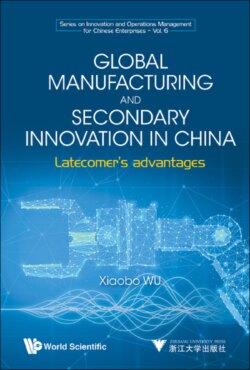Читать книгу Global Manufacturing and Secondary Innovation in China - Xiaobo Wu - Страница 9
На сайте Литреса книга снята с продажи.
Contents
ОглавлениеChapter 1 Introduction
1.1 New trend of globalization
1.2 China’s manufacturing industry’s participation in globalization
1.2.1 Growth of inbound foreign investments fluctuates and its proportion gradually decreases
1.2.2 Outbound investment quickly rising and net capital output achieved
1.2.3 Increasingly diversified investment and steadily growing cross-border M&As
1.2.4 Investable industries increasingly diversify, and the technology-driven investment becomes the major trend
1.3 Innovation capability building of China’s manufacturing industry
1.3.1 Production efficiency
1.3.2 Technological innovation capabilities
1.4 Opportunities and challenges faced by China’s manufacturing industry
1.4.1 Opportunities
1.4.2 Challenges
1.5 Research intention and structure of this book
Bibliography
Chapter 2 Theoretical and Practical Background of Secondary Innovation
2.1 Theoretical background
2.1.1 Latecomer’s advantages and disadvantages
2.1.2 Introduce, digest, absorb and re-innovate technologies
2.1.3 Technological paradigms and catch-up traps
2.2 Practical background
Bibliography
Chapter 3 The Dynamic Model of Secondary Innovation
3.1 Primary innovation
3.2 Model of secondary innovation
3.3 The evolutionary process of secondary innovation
3.3.1 Sub-process I: Imitative innovation (as shown in Diagram 3-3)
3.3.2 Sub-process II: Creative imitation (as shown in Diagram 3-4)
3.3.3 Sub-process III: Improved innovation (as shown in Diagram 3-5)
3.4 Post-secondary innovation
3.5 Case: Core technologies of ZTE
3.5.1 Introduction and imitation of the core technologies
3.5.1.1 Exploitative learning of the core technology
3.5.1.2 Exploratory learning of the core technology
3.5.2 ZTE’s learning of assistive technologies
3.5.2.1 Utilization of localized design capabilities
3.5.2.2 Exploration of assistive technologies
3.5.2.3 Assistive technology utilization based on alliance cooperation
3.5.2.4 Longitudinal stage division and joint evolution analysis
3.6 Summary
Bibliography
Chapter 4 Theoretical Model of Evolution and Development of the Secondary Innovation
4.1 Model of secondary innovation process based on global competition
4.2 Case: Haier Group’s journey of secondary innovation
4.2.1 Haier’s technology evolution: Taking refrigerator products as an example
4.2.2 The process of organizational change of Haier
4.2.3 Featured activities of Haier at the stages of secondary innovation
4.2.4 Conclusion and inspiration
4.3 Secondary business-model innovation and technological innovation
4.3.1 Secondary business-model innovation
4.3.2 Business model innovation and technological innovation
4.4 Case: The co-evolution of secondary business-model innovation and technological innovation in Alibaba
4.5 Summary: Two pathways from secondary innovation to beyond catch-up
Bibliography
Chapter 5 Secondary Innovation and Dynamic Modes of Organizational Learning
5.1 Organizational learning and secondary innovation
5.1.1 Organizational learning
5.1.2 Unlearning
5.1.3 The significance of organizational learning to secondary innovation
5.1.3.1 Learning is a basic function of the organization
5.1.3.2 Organizational learning is the premise and foundation to organizations’ survival and development
5.1.3.3 Organizational learning provides a good opportunity for firms to comprehensively enhance their competitiveness
5.1.3.4 The secondary innovation is a dynamic process of continuous learning by the organization
5.2 Dynamic organizational learning mode during secondary innovation
5.2.1 Dynamic feature of knowledge development in the secondary innovation process
5.2.2 Levels of organizational learning
5.2.3 Dynamic organizational learning mode
5.3 Case: The evolution of organizational learning mode based on dynamic process of secondary innovation: A longitudinal case study of Hangyang
5.3.1 Transitional learning in the phase of crisis (1994–1995)
5.3.1.1 Technical capability enhancement and its milestones
5.3.1.2 Technical efforts and features of organizational learning
5.3.2 The creative learning at the renewal (Type II introduction) stage (1996–1998)
5.3.2.1 Technical capability enhancement and its milestones
5.3.2.2 Technical endeavors and features of organizational learning
5.3.2.3 Introducing non-complete set of emerging technologies via cooperative R&D
5.3.2.4 The combination of “software” and “hardware” introduction
5.3.3 Maintainable learning at the stage of digestion and absorption (1998–2002)
5.3.3.1 Technical capability enhancement and its milestones
5.3.3.2 Technical endeavors and features of organizational learning
5.3.4 Developmental learning at the stage of improvement and innovation (2002–2008)
5.3.4.1 Technical capability enhancement and its milestones
5.3.4.2 Technical endeavors and features of organizational learning
5.4 Summary: The dynamics of technology introduction and organizational learning
Bibliography
Chapter 6 Cultivating Technological Innovation Capabilities during the Dynamic Process of Secondary Innovation
6.1 Technological innovation capabilities
6.2 Cultivating technological innovation capabilities during secondary innovation
6.2.1 Imitative innovation capabilities
6.2.2 Creative imitative innovation capabilities
6.2.3 Improved innovation capabilities for mature technologies
6.3 Enhancing technological innovation capabilities during secondary innovation
6.3.1 Cultivating dynamic capabilities in secondary innovation
6.3.2 From technology introduction to technology collaboration
6.4 Acquiring and reconstructing the technological capabilities during secondary innovation
6.4.1 Strategies for acquiring capabilities in secondary innovation
6.4.1.1 Technology introduction strategy
6.4.1.2 Technological alliance strategy
6.4.2 Process for building capability in post secondary innovation
6.5 Case: Hikvision: Technological capability building from secondary innovation to beyond catch-up
6.5.1 Secondary innovation in developing video compression board card
6.5.2 Comprehensive deployment, front-end extension, developing all-round technological innovation capabilities
6.5.3 With internal and external coordination, R&D culture promotes fundamental change of innovation
6.6 Summary
Bibliography
Chapter 7 Construction of Organization’s Management System during the Dynamic Process of Secondary Innovation
7.1 The construction of organization’s management system
7.1.1 Ambidexterity of the organizational system
7.1.2 Internal organizational network
7.1.2.1 Internal knowledge network in organization
7.1.2.2 Internal R&D collaboration network in organization
7.1.3 Organizational R&D network
7.1.4 Cross-functional collaboration system
7.2 Organizational transformation and secondary innovation
7.3 Case: Huawei: Innovation driven by organizational transformation
7.3.1 Aligning innovation demands with organizational changes
7.3.2 Systematic organizational transformation
7.3.3 Adjustment of decision-making mechanism
7.4 Summary
Bibliography
Chapter 8 Summary and Implications
8.1 Summary
8.2 Implications
Index
